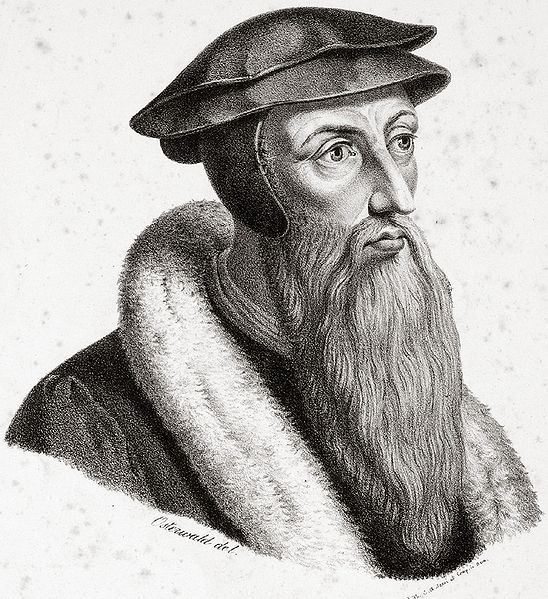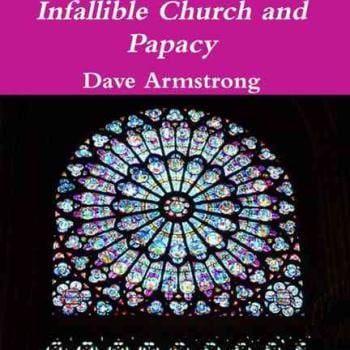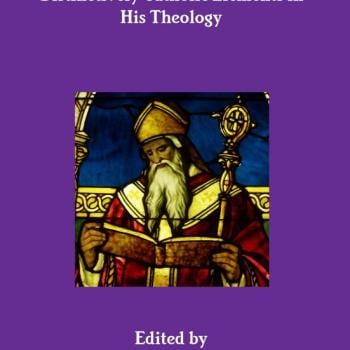
(4-9-04, 9-7-05, abridged and re-edited on 11-30-17)
***
[see the original series of three debates (one / two / three) with Reformed Protestants]
[John Calvin’s words will be in blue]
***
Either Jesus’ body and blood are substantially present or not. If they are, then they are really there! You can’t deny that the elements are transformed (Catholic view) or joined by the true body and blood (Lutheranism) and still hold that there is substantial or “real” presence. Why? Because this is an internal contradiction. Calvin is saying that Jesus is simultaneously there and not there. Even God is bound to that sort of elementary logical distinction. God can’t be and not be at the same time. And He can’t be “here” and “not here” at the same time.
Miracles are not irrational. The supernatural is not irrational; it simply transcends natural laws governing matter or is outside of it (as spirit, since science and naturalism deals with matter). It will do no good to simply say, “it is above our understanding, and so we will construct irrational scenarios and not try to make them coherent. It’s a mystery . . . ”
The bottom line is my original criticism about this “mystical view” of Calvin: if Jesus is really there it seems that he must adopt either a Catholic or Lutheran position. If He isn’t really (substantially?) there, then the Calvinist Eucharist is scarcely distinguishable fro the omnipresence of God or Zwinglianism. So God is there but is not “really” or “substantially” there. So what? How is that particularly special or unique? It still appears to me to be a “mystical Zwinglianism.”
I don’t understand how saying Jesus is “mystically” (but not substantially) present is logically distinguishable from pure Zwinglian symbolism, or how this is a miracle at all, because Jesus is already “mystically present” at all times and even lives within us. What sense does it make to say that “He is always here spiritually and now He is here ‘in Spirit more than He was’ “? Spirits have no spatial or quantitative qualities. It reminds me of the Jehovah’s Witness “invisible” return of Jesus in 1914. No one saw anything, but it really happened!
If we take away the conversion of the elements and transubstantiation, the distinctiveness and “sacramentality” of the miracle is abolished, thus we deprive the rite of its very essence. Unless something physical is there, it can’t be a sacrament, by definition, because a sacrament is the conveying of grace by physical means. If it isn’t substantial, it reduces to symbolism, because (at least in my analysis, for what it’s worth), why should we receive a spiritual presence that we already have through omnipresence and the indwelling? So it strikes me as betwixt and between; neither fish nor fowl.
Calvin’s and the Calvinist eucharistic view involves massive self-contradiction:
1. Jesus is physically present in the Supper.
2. But He is physically present at the right hand of God.
3. We are physically present with Christ in the Supper.
4. But we are physically present with Christ at the right hand of God.
Contradictions: 1 vs. 2, 3 vs. 4, 2 vs. 3, and 1 vs. 4.
Why take this view but oppose the view that Jesus is sacramentally present in the Supper? God can perform miracles but He can’t transcend the laws of logic. If we want to restrict ourselves solely to the literal post-Resurrection body of Christ, then we can’t say that is “physically present” in the Supper while simultaneously at the right hand of God, because that is a contradiction, as much as it would be a contradiction to say that Jesus was physically present in Jerusalem during His crucifixion, but simultaneously at the Sea of Galilee.
But the Catholic view is not contradictory because the miracle of transubstantiation is an additional mode of presence of Jesus that is physical in a way approximating spiritual omnipresence (similar in a sense to His post-Resurrection body when He appeared to His disciples and seemed to walk through walls). We are not with Jesus in heaven yet but He is sacramentally and eucharistically with us, by the miracle of the transformation of the elements. In other words, one has to posit the additional miracle of transubstantiation (or at least consubstantiation) in order to have the physical presence.
If Calvin and the Reformed believe that we are actually transported to heaven to meet Jesus there (during Holy Communion), why is it so difficult to believe that He can substantially be present here under the appearances of bread and wine? Both scenarios involve something that transcends our senses, and must be believed on faith. But I think one involves a logical contradiction and the other does not.
We say it is the accidents which are spiritual and not what they appear to be. So Reformed say, “He is truly here physically, but you are not physically eating His body.” Catholics say, “He is truly here physically, and you are physically eating His body, even though it appears to be merely bread and wine.” I do see a certain symmetry between the two views because both are saying that you have to deny the evidence of your senses and believe that something miraculous is taking place. The difference is that we cannot yet be in heaven with Jesus because we are not yet glorified bodies and spirits as He is. He can make Himself physically present with us because He is God and can do anything. We can’t literally be with Jesus in heaven until we die and go there or unless we have some miraculous experience like Paul, being taken up to the third heaven.
Sure, we must all admit that God could conceivably perform a miracle like that, too, but I see no reason to believe that He in fact does, because there is no indication in Scripture that such a thing occurs at every Eucharist. Thus, I would say that the Reformed view fails the tests both of Scripture and patristic belief.
We’re told by Reformed that Jesus is physically present at the Lord’s Supper, but not in the bread (or what was formerly bread). This makes no sense, and is contradictory:
1. Jesus is physically present in the Supper.
2. Jesus is not physically present in the bread and wine.
3. But the Supper and the bread and wine are synonymous.
4. Therefore, it follows that Jesus is somehow physically present and not physically present at the same time, which is a contradiction and impossible.
If Reformed Protestants want to stress the literal human body of Jesus in heaven (and the counter-charge is that we are somehow minimizing this in our view, and obliterating Chalcedonian Christology), and want to make the Eucharist dependent on, or limited by that, then it is strange to make Jesus “physical” in the Eucharist (but not in the bread) and to hold that “the Holy Spirit, in this Sacrament, raises us to Christ where, mysteriously, we feed on his true body and blood.” It’s this constant irrational shifting between “mystical” and “physical” which is the problem. Reformed Protestants refer to a literal feeding on Christ, but He is in heaven, etc. . . . But now we are told that it is a “mystical” presence. So which is it? And how is any of this less difficult to believe than transubstantiation?
I see little (if any) indication in either Scripture or the history of doctrine prior to Calvin and Zwingli that we somehow meet Jesus in heaven (“physically”) during the Eucharist before we actually arrive there after death.
Transubstantiation is not self-contradictory. It is a difficult concept, unusual, a profound miracle which requires exceptional faith, but involves no logical inconsistency. God can do any miracle He so chooses. He can transform the bread and wine into His Body and Blood. That makes sense to me because if God could become a Man He can make Himself substantially present in consecrated elements that were formerly bread and wine.
But the view Reformed Protestants describe strikes me as quite incoherent. God became a Man, and He is omnipresent. But neither men nor heaven are omnipresent nor able to be transformed in a second. Jesus has a real body in heaven, and heaven is a place. We will go there one day if we are among the elect, or we will go to hell.
So why should we believe that we literally visit heaven when we receive the Eucharist? This sounds more like “beam me up Scotty” than biblical Christianity! Do we cease to be in the location we are worshiping in when we receive communion? We are then in heaven with the literal body of Jesus? How long do we stay there? How do we know when we have returned? Since heaven is distinct from the earth, we can’t be here and there at the same time. So this position means that we must leave the earth during communion. Apparently it has to be literal because we’re told that we truly receive Jesus’ body substantially, and Calvin restricts His literal body to heaven.
This requires a transformation of physics to the extent that a contradiction is involved. Why should I believe I am in heaven during this time when there is no outward evidence of it whatsoever? I suspect the comeback would be, “What’s the essential difference? Why should we believe bread and wine have become transformed into body and blood?” It is true that transubstantiation goes beyond the senses too, but it involves God becoming bodily present to us here on earth. We know that is both plausible and entirely possible because of the incarnation.
But in the Calvinist view, it is not God who miraculously appears; rather it is heaven and earth and man which are involved. Since heaven and earth are distinguishable, we can’t say we are in both at the same time. Men are not like God. We have no attributes like omnipresence or bilocation. And I see no compelling reason to believe that God performs these super-extraordinary miracles every time we receive the Eucharist.
What is also curious to me is the comparison in this thinking between the concern that Jesus’ body is in heaven (and if we allow His body to also be here on earth we are supposedly denying Chalcedon), with the simultaneous belief that mere men’s bodies can be taken up to heaven while we are looking at them ostensibly remaining here in a church. One idea is replaced with another (in my opinion) far more implausible and a priori unlikely one.
The same serious problem remains: if we can only receive Jesus’ body substantially in heaven, then we have to go there to receive Him, and this defies all outward appearances. It would require a miraculous transformation of our bodies, and some strange reversal of the location of heaven and earth. Calvin wrote in his Institutes (IV, 17, 12):
For as we do not doubt that Christ’s body is limited by the general characteristics common to all human bodies, and is contained in heaven (where it was once for all received) until Christ return in judgment, so we deem it utterly unlawful to draw it back under these corruptible elements or to imagine it to be present everywhere.
This is the incoherence and implausibility of Calvin’s view (as I see it) in a nutshell: Calvin limits Christ’s body to heaven, as if it is unthinkable and a priori impossible (“utterly unlawful”) for God to choose to make Himself present in the matter of bread and wine, just as He became Man. But then he turns around and grants these remarkable qualities to men, so that we can somehow go to heaven to receive Jesus’ body which can only be localized there (as if it is more likely for God to let men have these qualities rather than Himself). Is this not strange?
While denying that Jesus can perform miracles with His body and become substantially present under the appearances of bread and wine, Calvin prefers to give the miraculous, spectacular qualities to men‘s bodies. But we’re not the ones who walked on water, who walked through walls, who were resurrected from the dead (not yet) or who ascended to heaven (and came down from heaven also). Why is it “unlawful” for Jesus to become eucharistically present on earth, but totally believable for us to become present in heaven to worship God and receive Him? This makes no sense.
Furthermore, Calvin caricatures the Catholic and Lutheran Eucharist in saying that those positions require that Christ’s body is “present everywhere,” rather than the Holy Spirit. Omnipresence refers to spirit, not matter. Being present bodily in many places is not being present everywhere. If Jesus could multiply the loaves and fishes, why could He not multiply His body and blood, to be sacramentally and physically present in consecrated elements? I see (contra Calvin) no reason to believe why He could or would not do so. Calvin reiterates in Institutes, IV, 17, 30:
Unless the body of Christ can be everywhere at once [same category mistake repeated], without limitation of place, it will not be credible that he lies hidden under bread in the Supper.
Also:
. . . placing the body itself in the bread, they assign to it a ubiquity contrary to its nature . . . (IV, 17, 16)
So Christ Himself (Who is omnipotent; and Calvin accepts that, last time I checked) is limited by place, but we are not? God makes us somehow go to heaven to receive the Eucharist? If we can only receive Jesus substantially there, then we need to go there. But then we have characteristics that Calvin curiously denies even to Jesus’ body. That is odd enough. If, on the other hand, we don’t go to heaven to receive Him, then we do not receive His literal body, since Calvin (by some incomprehensible reasoning known only to himself) restricts it to heaven. Either way, it is implausible and illogical.
Calvin specifically restricts Christ’s body to heaven. But he says that we go up to heaven only “with our eyes and minds”:
But if we are lifted up to heaven with our eyes and minds, to seek Christ there in the glory of his Kingdom, as the symbols invite us to him in his wholeness, so under the symbol of bread we shall be fed his body . . . (IV, 17, 18)
So here he denies that we literally go to heaven. Therefore, how can we receive Jesus’ body substantially since Calvin has already limited Jesus to heaven? It can only (given simple logic) be symbolic, thus we are back to Zwingli again. Calvin keeps contradicting himself over and over:
This Kingdom is neither bounded by location in space nor circumscribed by any limits. Thus Christ is not prevented from exerting his power wherever he pleases, in heaven and on earth. (IV, 17, 18)
Huh??? Why, then, does Calvin rule out a local bodily presence on earth in the Eucharist, and rail against transubstantiation as if it were the devil himself?:
. . . we do not think it is lawful for us to drag him from heaven. (IV, 17, 31)
Yet Calvin thinks his view:
. . . contains nothing either absurd or obscure or ambiguous . . . (IV, 17, 19)
I beg to differ. Calvin rails against the Catholic view, yet when it comes time to explain the incoherence and contradictions in his own view, he conveniently appeals to mystery:
Now, if anyone should ask me how this takes place, I shall not be ashamed to confess that it is a secret too lofty for either my mind to comprehend or my words to declare . . .
Those who are carried beyond this by their own exaggerations do nothing but obscure simple and plain truth . . . we are now discussing a sacrament the whole of which must be referred to faith. (IV, 17, 32)
I’m sure Calvin can’t fully explain himself, but in any event, the presence of demonstrated logical contradiction would rule out a view, no matter how much or how little we understand it. And that is my present critique. Moreover, if his view requires faith, why can’t Catholics hold to their beliefs in faith without being accused of a host of ridiculous things by Calvin?
But then I don’t know how much Calvin’s view developed after the Institutes. Perhaps these contradictions were alleviated.
Nor do I see such a thing in Scripture. God can make the Cross become present to us again in the Sacrifice of the Mass because He is outside of time and everything is “present” or “now” to Him. And so we see reference to a “Lamb slain” in heaven. But I see no indication that the Eucharist involves this “heavenly transplantation”.
Calvin and his followers provide a few biblical passages: Hebrews 6:4-8 is not about the Eucharist, but about apostasy. We can hardly deduce a heavenly eucharistic service from the phrase “tasted of the heavenly gift.” Nor is it clear that “partakers of the Holy Spirit” refers to more than the Indwelling and the Spirit’s guidance as the Paraclete.
As for Hebrews 10:19-25, Calvin himself relegates the passage to allegory, in his Commentary on Hebrews (dated 1549):
10:19: . . . he allegorically describes the access which Christ has opened to us.
He does, however, also state:
. . not only symbolically, but in reality an entrance into heaven is made open to us . . .
But he doesn’t elaborate as to how this occurs. Nor does he seem to apply this interpretation to Hebrews 12:18-24, in the same Commentary.
***
Some elements of Calvin’s presentation seem to be quite close to transubstantiation, and others seem to me either playing with words, and smacking of internal incoherence and inconsistency (my initial impression of his eucharistic theology) or a glorified “mystical Zwinglianism,” or a system closer to that than to the Catholic and Lutheran beliefs.
St. Thomas Aquinas denies that Jesus’ body is in the Eucharist “locally” or “as in a place.” Would that overcome Calvin’s objection about Jesus being at the right hand of the Father?:
Whether Christ’s body is in this sacrament as in a place?
Objection 1: It seems that Christ’s body is in this sacrament as in a place. Because, to be in a place definitively or circumscriptively belongs to being in a place. But Christ’s body seems to be definitively in this sacrament, because it is so present where the species of the bread and wine are, that it is nowhere else upon the altar: likewise it seems to be there circumscriptively, because it is so contained under the species of the consecrated host, that it neither exceeds it nor is exceeded by it. Therefore Christ’s body is in this sacrament as in a place.
Objection 2: Further, the place of the bread and wine is not empty, because nature abhors a vacuum; nor is the substance of the bread there, as stated above (Question [75], Article [2]); but only the body of Christ is there. Consequently the body of Christ fills that place. But whatever fills a place is there locally. Therefore the body of Christ is in this sacrament locally.
Objection 3: Further, as stated above (Article [4]), the body of Christ is in this sacrament with its dimensive quantity, and with all its accidents. But to be in a place is an accident of a body; hence “where” is numbered among the nine kinds of accidents. Therefore Christ’s body is in this sacrament locally.
On the contrary, The place and the object placed must be equal, as is clear from the Philosopher (Phys. iv). But the place, where this sacrament is, is much less than the body of Christ. Therefore Christ’s body is not in this sacrament as in a place.
I answer that, As stated above (Article [1], ad 3; Article [3]), Christ’s body is in this sacrament not after the proper manner of dimensive quantity, but rather after the manner of substance. But every body occupying a place is in the place according to the manner of dimensive quantity, namely, inasmuch as it is commensurate with the place according to its dimensive quantity. Hence it remains that Christ’s body is not in this sacrament as in a place, but after the manner of substance, that is to say, in that way in which substance is contained by dimensions; because the substance of Christ’s body succeeds the substance of bread in this sacrament: hence as the substance of bread was not locally under its dimensions, but after the manner of substance, so neither is the substance of Christ’s body. Nevertheless the substance of Christ’s body is not the subject of those dimensions, as was the substance of the bread: and therefore the substance of the bread was there locally by reason of its dimensions, because it was compared with that place through the medium of its own dimensions; but the substance of Christ’s body is compared with that place through the medium of foreign dimensions, so that, on the contrary, the proper dimensions of Christ’s body are compared with that place through the medium of substance; which is contrary to the notion of a located body.
Hence in no way is Christ’s body locally in this sacrament.
Reply to Objection 1: Christ’s body is not in this sacrament definitively, because then it would be only on the particular altar where this sacrament is performed: whereas it is in heaven under its own species, and on many other altars under the sacramental species. Likewise it is evident that it is not in this sacrament circumscriptively, because it is not there according to the commensuration of its own quantity, as stated above. But that it is not outside the superficies of the sacrament, nor on any other part of the altar, is due not to its being there definitively or circumscriptively, but to its being there by consecration and conversion of the bread and wine, as stated above (Article [1]; Question [15], Article [2], sqq.).
Reply to Objection 2: The place in which Christ’s body is, is not empty; nor yet is it properly filled with the substance of Christ’s body, which is not there locally, as stated above; but it is filled with the sacramental species, which have to fill the place either because of the nature of dimensions, or at least miraculously, as they also subsist miraculously after the fashion of substance.
Reply to Objection 3: As stated above (Article [4]), the accidents of Christ’s body are in this sacrament by real concomitance. And therefore those accidents of Christ’s body which are intrinsic to it are in this sacrament. But to be in a place is an accident when compared with the extrinsic container. And therefore it is not necessary for Christ to be in this sacrament as in a place.
Here are instances of Calvin’s use of “substance” (and a few of “presence”) in his Short Treatise on the Lord’s Supper). Emphases are added:
. . . the substance of the sacraments is the Lord Jesus . . . It is necessary, then, that the substance should be conjoined with these, otherwise nothing would be firm or certain. Hence we conclude that two things are presented to us in the Supper, viz., Jesus Christ as the source and substance of all good; and, secondly, the fruit and efficacy of his death and passion. (11)
. . . all the benefit which we should seek in the Supper is annihilated if Jesus Christ be not there given to us as the substance and foundation of all. (12)
. . . in order to have our life in Christ our souls must feed on his body and blood as their proper food. This, then, is expressly attested in the Supper, when of the bread it is said to us that we are to take it and eat it, and that it is his body, and of the cup that we are to drink it, and that it is his blood. This is expressly spoken of the body and blood, in order that we may learn to seek there the substance of our spiritual life. (13)
Thus it is with the communion which we have in. the body and blood of the Lord Jesus. It is a spiritual mystery which can neither be seen by the eye nor comprehended by the human understanding. It is therefore figured to us by visible signs, according as our weakness requires, in such manner, nevertheless, that it is not a bare figure but is combined with the reality and substance. It is with good reason then that the bread is called the body, since it not only represents but also presents it to us . . . the sacraments of the Lord should not and cannot be at all separated from their reality and substance. (16)
We must confess, then, that if the representation which God gives us in the Supper is true, the internal substance of the sacrament is conjoined with the visible signs; and as the bread is distributed to us by the hand, so the body of Christ is communicated to us in order that we may be made partakers of it. Though there should be nothing more, we have good cause to be satisfied, when we understand that Jesus Christ gives us in the Supper the proper substance of his body and blood, in order that we may possess it fully, and possessing it have part in all his blessings. (17)
. . . feeding on his own substance. (18)
. . . the reality and substance of the Supper . . . (30)
. . . the presence and conjunction of the reality with the sign (of which we have spoken, and will again speak) is well understood. (43)
Zuinglius and Œcolompadius . . . forgot to show what presence of Jesus Christ ought to be believed in the Supper, and what communion of his body and blood is `there received . . . Luther thought that they meant to leave nothing but the bare signs without their spiritual substance. Accordingly he began to resist them to the face, and call them heretics. (56-57)
. . . on receiving the sacrament in faith, according to the ordinance of the Lord, we are truly made partakers of the proper substance of the body and blood of Jesus Christ. (60)
Likewise, in the Institutes, Calvin insists on denying “local physical presence,” yet continues to insist that the recipient of communion receives Jesus’ literal “substantial” body and blood. Either he is contradicting himself right and left and simply doesn’t care (the “faith has nothing to do with logic” outlook) or he hasn’t shown how his view is at all superior to transubstantiation theologically or logically, thus making his extremely hostile rhetoric against transubstantiation and the Sacrifice of the Mass mostly empty, groundless rhetoric. Here are some more relevant quotes, from the Beveridge translation of the Institutes, available online:
The presence of Christ in the Supper we must hold to be such as neither affixes him to the element of bread, nor encloses him in bread, nor circumscribes him in any way, (this would obviously detract from his celestial glory;) and it must, moreover, be such as neither divests him of his just dimensions, nor dissevers him by differences of place, nor assigns to him a body of boundless dimensions, diffused through heaven and earth . . . But when these absurdities are discarded, I willingly admit any thing which helps to express the true and substantial communication of the body and blood of the Lord, as exhibited to believers under the sacred symbols of the Supper, understanding that they are received not by the imagination or intellect merely, but are enjoyed in reality as the food of eternal life. (IV, 17, 19)
We say that Christ descends to us, as well by the external symbol as by his Spirit, that he may truly quicken our souls by the substance of his flesh and blood. (IV, 17, 24)
Still I am free to confess that that mixture or transfusion of the flesh of Christ with our souls which they teach I repudiate, because it is enough for us, that Christ, out of the substance of his flesh, breathes life into our souls, nay, diffuses his own life into us, though the real flesh of Christ does not enter us. (IV, 17, 32 — a remarkably incoherent and contradictory statement)
***
In Douglas Farrow’s article, “Between the Rock and a Hard Place: In Support of (something like) a Reformed View of the Eucharist,” my difficulty is at least expressed (if not granted):
“Might it not be admitted that there is a fundamental problem with Calvin’s sursum corda and with his interpretation of the eucharistic mystery — viz., that the body of the worshipper, unlike his or her soul, appears to be uninvolved in the secret union and communion with Christ in the heavenlies . . . ?” (p. 4 in pdf file)
Describing Aquinas’ view on the next page, Farrow writes:
“. . . by virtue of his divine omnipresence and omnipotence as the Logos, Jesus is able to provide on earth a eucharistic form of his humanity under the accidents of the bread and wine, making present (albeit non-spatially) the actual substance of his exalted body and blood . . . Was Calvin . . . over-hasty in exchanging this account of the presence of the absent Christ for one which leaves Christ strictly in heaven, and which postulates rather a secret relocation of the worshipperthrough faith and the ministry of the Spirit? . . . If we are not permitted to appeal to the miracle of transubstantiation, how are we to conceive of a real union of soul and body with the heavenly Christ? . . . Prima facie it is by no means apparent that a simple appeal to the Spirit can justify such claims, if by them we mean to include our corporeal nature and with it the entire sphere of human culture.”
On p. 12 he states:
“The simple fact of the matter is that Calvin’s view is not unlike that of Aquinas — which is to say, it is an entirely orthodox view, however tainted by cosmological misinformation.”
See also his footnote 41 on p. 14:
“. . . one meets today relatively few Reformed theologians who take the eucharist with anything like the seriousness that Calvin did.”
[Earlier he had noted that the notable 19th-century Presbyterian theologian Charles Hodge actually had a Zwinglian view]
In good scholarly fashion, Farrow mentions these difficulties of mine in his overview of the controversy, but doesn’t really answer them (at least not to my satisfaction). So I continue to seek answers to the dilemma.
***
I disagree with Calvin’s view and find it self-contradictory, and of course I don’t care for his excessive polemical lambasting of the Catholic position, but I can appreciate the view that his theology is far more “realist” than the usual Protestant position today (even amongst his own followers, according to you guys who have commented on that).
Calvin’s eucharistic theology reminds me of Luther’s Mariology: both were much “higher” than most later Lutherans and Calvinists held. Those facts lend themselves to the view that some Protestant theological trends seem to be primarily of a negative nature” in reaction to Rome rather than proactive and proceeding from the best in Protestant internal principles, from the thought of the key figures of Luther and Calvin.
Calvin adheres to a “mystical presence.” Luther and Catholics accept substantial presence (which is a more accurate term for our view than “real presence”). I think Calvin’s view (with all due respect) is confused, and not able to be defended on solid philosophical (or for that matter, theological and exegetical) grounds. It seems incoherent and, frankly, strange, to me. He wants the presence of Christ to be real, yet he has to separate the consecrated elements by making them symbols. I don’t see how this mode of “presence” is distinguishable from God’s omnipresence. Of course, God is everywhere, and He is always everywhere. So of what additional use is a symbolic (or semi-symbolic) “reality” that is not substantial?
The whole miracle of the Eucharist is that it is an extension of the incarnation: Jesus actually became a man: a physical person, and walked among us. Transubstantiation means that Jesus is actually present just as He was when He walked the earth. But the rub is that it always requires faith to believe this, because the accidents remain the same, and it seems nonsensical to a naturalistic mind that what looks like bread and wine really aren’t. I think that causes disbelief in it: I would call it an excessive rationalism, and I say that Calvin (and Zwingli) succumbed in part to that. They can’t accept the miracle that all the Fathers accepted.
Of course the comeback is that it is not a “rational” thing, but a mystery, but I reply that even mysteries don’t have to be (indeed, should not be) contrary to reason; they can be reasonable as far as reason goes, and then require faith for those aspects which transcend (but do not contradict) reason.
This is the Catholic view: always reason and faith; not faith and reason some of the time, or reason and faith some of the time, or faith and unreason, or faith as unalterably opposed to reason, etc. We will not yield the mind or reason. The Bible doesn’t require such a thing. So why does anyone go that route? I’ve never understood it.
***
Catholic mystical theologian Matthias Scheeben wrote about the Eucharist in his book, The Mysteries of Christianity (translated by Cyril Vollert, S. J., St. Louis: B. Herder Book Co., 1952; from 1887 edition, pp. 485-486, 488):
The Eucharistic presence of Christ is in itself a reflection and extension of His incarnation, as the Fathers so often observe. The changing of the bread into the body of Christ by the power of the Holy Spirit is a renewal of the wonderful act by which, in the power of the same Holy Spirit, He originally formed His body in the womb of the Virgin and took it to His person . . .
But this presence is multiplied only that the body of Christ may grow and spread throughout the members which He attaches to Himself and fuses with Himself. For this reason alone the true body of Christ is reproduced at the Consecration, that He may unite Himself with individual men in Communion and become one body with them, so that the Logos may, as it were, become man anew in each man, by taking the human nature of each into union with His own . . .
So completely do we become one with Christ that we can say with deep truth that we belong to the person of Christ, and in a sense are Christ Himself. “Christ is the Church,” says St. Hilary, ‘bearing it wholly within Himself by the sacrament of His body’ . . .
This participation in the divine nature is at the same time a replenishing of man with the Holy Spirit and a fellowship with Him. Since the Holy Spirit dwells in the body of Christ in a quite singular way by a very real union, He must also pour Himself out upon those who have been joined to Christ in one body. That we are filled with the Holy Spirit, that the Eucharist becomes a fellowship with the Holy Spirit for those who partake of it, and that we are all joined to one another in the fellowship of the one Holy Spirit, we find indicated in the ancient liturgies as the aim and effect of the Eucharist.
***
Photo credit: John Calvin, by Georg Osterwald (1803–1884) [public domain / Wikimedia Commons]
***













